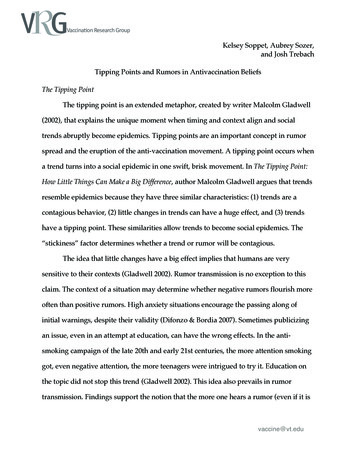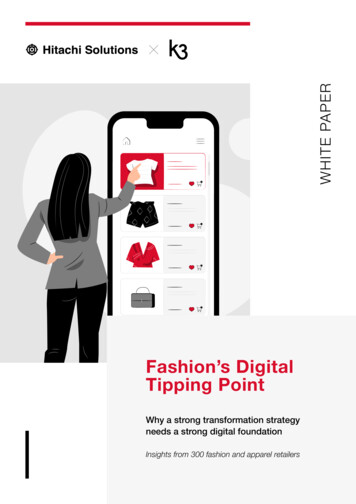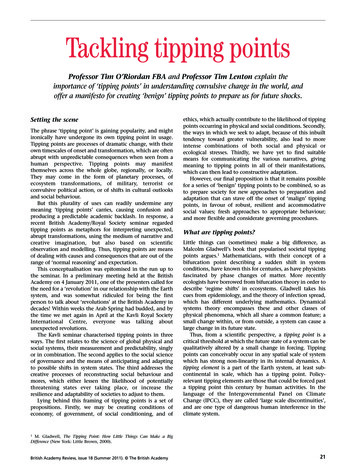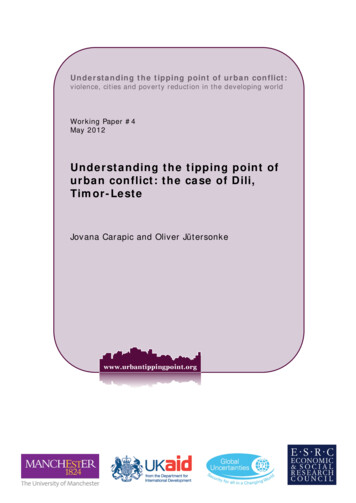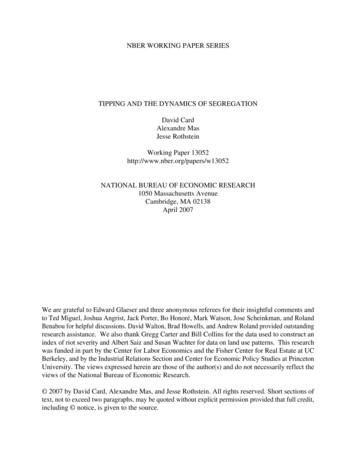
Transcription
Passing the tipping pointfor digital: the nudge effectof the pandemicA Northern Ireland Perspective
02Passing the tipping point for cutive summaryUnblocking NorthernIreland’s digital futureA changing landscape for NorthernIreland in a complex COVID-19 worldWorking together toovercome obstaclesEncourage andinclude everyoneStop the skills shortageEmbrace a digitallyrich futureTrust a single citizen viewConclusion: Planningfor a successful future03
0405Passing the tipping point for digitalIntroductionDuring this time our public and private sector leaders have been busy. As part ofour Changing Landscapes series in this report, we look at how Northern Irelandhas been transforming services, supporting employees, and figuring out how tothrive in this strange new world.Our social and workplace interactions areCompared against our findings from our lastnow more digital than ever, changing how wereport, we look at the impact the globalall connect to each other and our communities.pandemic has had on the digital landscape inThis has left the public sector with no choicethe region, and ask what lessons can be learnt,but to adapt and rethink how to support thewhat steps can be taken, and how our nationchanging landscape.can prosper in this challenging environment.With no end in sight to the pandemic anda recession already upon us, where does thisleave public services today?We brought together leaders from acrossNorthern Ireland to discuss the changingbehaviour of its citizens, combining resultsfrom two new pieces of citizen researchtaken before and during the pandemic.Introduction
07Passing the tipping point for digitalExecutive summaryWhen we wrote our first report, in February 2019, we talked about turbulenttimes ahead. For most of us, the biggest change in the last two years – andfor many in living memory – was the onset of the global COVID-19 pandemic.Forever remembered as the year we ‘stayed at home’.The response to the pandemic so far hasshown across all our sectors our ability to worktogether, better and faster than ever. Evenwhen kept apart.If we were unsure before, it’s now clear thatour nation continues to be an innovative techhub, able to collaborate, tackle challenges andabove all else champion change for the public.Led by a national impetus for better digitaltechnologies and reliable online services,“In the last two years, Civica hassurveyed Northern Irish citizensthree times, to gauge how theyrate and use our public sectordigital services. Each time theresults show more demand foronline access – but we don’tseem to match that demand withactual digital solutions.our need to connect is now embedded. Weare past a turning point, and there’s no goingback. Public appetite for use of technologyand online services has undergone a distinctshift, with people now recognising digital as aExecutivesummarydriver for better outcomes. In 2020, almost half(46%) of Northern Irish citizens we surveyedbelieve digital technologies can connect thecommunity or improve the lives of citizens –this has increased by nearly 10% in two years.Public sector organisations need torecognise and work with this change.The public sector can and doesdeliver well-constructed digitalservices and can do it with speedwhen it needs to. COVID-19has proven that. We need tolearn the lesson of this crisis andcollaborate to deliver more ofwhat the public is asking for.“06Mark Owens, Managing Director,Northern Ireland, Civica
0809Passing the tipping point for digitalHowever there are still many barriers to publicCan NI build and retain the next generationsector digital transformation. How can weof skilled digital workers? What strategies willunblock traditional mind-sets when buildingenable digital programmes to be more effectivemodern collaborative workplaces? How canfor citizens and easier for us to deliver? Indigital help us to keep pace with the privatethis report we put forward the views of publicsector and meet the changing and multi-service leaders against these key questions.diverse citizen expectations?Unblocking Northern Ireland’sdigital futureSupporting a need for continued digital transformation, this reportexplores what Northern Ireland needs to do within five key areas:1“Public sector leaders agree that morestrategic digital programmes are crucialat this time when digital communicationshave become central to our lives. Butto successfully lead these, we needcollaboration, closer partnerships withdigital suppliers and a procurementframework that puts the citizens’ needsabove all else.Now the challenge is for public andprivate sector leaders in NorthernIreland to continue to invest in initiativesdesigned to meet rapidly growingdemands in all areas of life. To supportcommunities, people and employeeson the difficult road ahead.“Mark Owens, Managing Director,Northern Ireland, Civica2345Work together to overcome obstaclesFoster better collaboration internally andexternally drive digital changeEncourage and include everyoneSupport each and every one of our citizensto access the services they want and needAddress the skills shortagePrepare our future leaders to drive NorthernIreland’s digital legacyEmbrace a digitally rich futureUnlock new technologies and ways ofworking to make citizens lives easierTrust a single citizen viewDrive efficiencies with data and enablesystems to safely share information
1011Passing the tipping point for digitalEvery leader in the public or private sector has to constantly consider the needsand demands of citizens. So, how have our needs changed? And whatdo we demand from the services we now receive?A changing landscapefor Northern Ireland ina complex COVID-19worldNearly1 in 234%Looking at companies that thrived throughoutOnly 6% of surveyed citizens believe onlinethe pandemic, their success was due to speed,public services will be less suited to theefficiency and making our lives as easy aspublic needs after the pandemic. Citizenspossible. An obvious example, Amazon. Theyare calling out for digital, and now expectdelivered against our needs – easy onlinegreater personalisation, intuitive experiencesaccess to millions of goods, quickly (and safely).and reliable outcomes from all of their serviceAs consumers, this is the standard we all nowneeds. At a time when we are relying onexpect. Amazon deliver within hours, so whydigital technology more than ever, this clearlydoes it take 14 days for the local council toneeds to be addressed. Nearly a third (30%)respond to an email?of surveyed citizens state that public servicesdo not currently make good use of digitalWhilst we stayed at home - many with childrentechnology to enhance their lives – a riseto support and educate, as well as doing ourof almost 5% in two years.day jobs - the demand for swift, easy digitalcommunications and services blossomed.Public and private sector organisations –surveyed adults nowof surveyed adults areTurning previous online “nice-to-have”if they haven’t already – need to think aboutbelieve digital will connectmore receptive to digitalexperiences into vital and sometimes life-the outcomes for citizens using a digitalthe communitysince COVID-19critical services.approach. To achieve this, public sector leadersagreed that this comes down to addressingCitizens now expect online services everywhereAlmosthalf81%of Northern Irish surveyed adultsof adults surveyed aresay they want to use digitalnow aware that mosttech more frequently forpublic services arepublic servicesavailable onlineas the demand has increased dramatically. Civicaresearch showed that almost half of surveyedcitizens (49%) say they want to use digital techmore frequently in the future.five key challenges.
1213Passing the tipping point for digital1Working together to overcome obstaclesFoster better collaboration internally andexternally drive digital change.“ Coming together is a beginning.Keeping together is progress.Working together is success.”Key attributes to successful collaboration include:Empowered employeesSharing for the greater goodBy giving employees the tools to work fasterSharing relevant systems, data and informationtogether and by implementing a collaborativeimproves services. Talking to one anotherand Procurement Delivery division onculture, organisations will have a much moremeans initiatives and pilots may work acrossthe one hand provides guidance,effective workforce.organisations and that can be acted upon.framework and project support, but cansometimes inhibit better and earliercooperation between the private andpublic sector. Public sector executivesLaunching COVID-19 critical apps at speedcollaboration and the introduction of aThe private and public sectors have their ownministerial position for digital to createstrengths, and have proven over time that theyBack in May, the Northern Irelandmore flexibility, fluidity and collaboration.Department of Health and Civicacan work well together to deliver essentialpublic services. During our leadership forum,launched a new COVID-19 symptom2. Mindsets: Collaboration isn’t justchecker mobile app - helpingthe attendees discussed how many of theprocurement or system-led. Peoplesuccesses in the public sector couldn’t havecitizens access immediate advicehave to want and be open to workingbeen done without some form of involvementand links to vital information as thetogether otherwise projects will likelyfrom the private sector.pandemic evolved.fail. Too often, insight is held isolated.“We need a style of leadership that realisesAt our leadership forum, when we asked howFrom initial kick-off meetings to launch,and understands that working together isfuture programmes can be even better, 75%the entire process took only two weeksbetter than operating alone - encouragingof surveyed public sector leaders agree thatand is an example of how a focusedan attitude of information sharing withinbuilding closer relationships is essential.approach on user outcomes from theand outside of our organisations.outset, can help streamline deliveryHelping create programmes designed aroundin record time.citizen needs, providing services that theyactually use.Everyone unanimously agreed that working inisolation is not the answer. So to createimpactful and effective digital programmes,we must first tackle two areas: Developed and deployed in just“ Public sector organisations need towork together to deliver smarter endto-end business service. It’s the onlyway we can get anything done; wecan’t get it done on our own.”1. Procurement challenges: The currentprocurement system in Northern Irelandis a contentious issue. The ConstructionGerry Thompson, Director DTS atDigital Transformation Servicetwo weeksWe recognised that peopleneeded access to up to dateinformation, and at this worryingtime, it was vital for us to act fast.The app has been hugelyhelpful to deliver a solution atscale - ensuring people couldcheck symptoms and up to dateinformation whilst ensuring lesspressure on critical resources.“are calling for a system that encourages Over 100,000 downloads Helping divert calls away from 111,from 6,000 per day to less than 1,000.Dan West, Chief Digital Officer,Department of Health NICase StudyHenry Ford
1415Passing the tipping point for digital2Encourage and include everyoneDigital technology is here to stay. Our jobnow is to ensure nobody is left behind.NI First Minister, Arlene Foster, has said thatthe region is entering a “new normal” postCOVID-19 and has challenged organisationsSo, what can public and privateto look at technological solutions tosector leaders do to support digitalsupport future ways of working and living.inclusion across the region?This starts by ensuring adequate access inWe’re now at the point where public andAwareness often isn’t the issue, adoption is.the first place.Encourage access to technology:although local libraries and otherprivate sector executives all agree that digitaltechnologies are vital to support our lives,Public awareness of online services isand keep every citizen connected.increasing with 81% of surveyed citizens nowaware that most public services are nowConnectivity across the region is alreadybeing improved, for example throughVirgin Media’s Project Lightning programmeand commitments from Openreach andplaces provide online access forcitizens, public service leaders shouldconsider offering pop-up centres.Run by the local council to provideOur citizens agree, as almost half of thoseavailable online. However, in many cases, thissurveyed (49%) say they want to use digitalawareness doesn’t always lead to adoption.tech more frequently. Our recent Word fromBefore 2020, citizens seemed wary, preferringthe Wise campaign highlighted over 70s whotraditional and personal interactions.feel tech is improving public services in NI –Without the luxury of many interactions wemore than any other age group (88%, whichonce expected, there is the opportunity and ais ahead of the rest of the UK and NI overallrequirement to educate the nation. Teaching theat 78%) – and shows they are engagingoften more vulnerable parts of our society whyand willing.it’s better and more convenient to use digitalconfidence. Through initiatives such asservices. This education is not only critical inpublic service-led training sessions, weHowever, you can’t ignore those that prefersupporting citizens’ current demands but alsocan build the confidence with thosemore traditional ways of accessing publictheir future ones.who need it.Fibrus to continue to invest in full- fibrebroadband services, which will supportthe region as many continue to work fromadvice and guidance on how toself-serve online, let users see thebenefits first-hand.home. However, according to Ofcom, 6% ofproperties in Northern Ireland are still unableto get decent access to broadband, whichis three times the level of the UK overall (2%).Build confidence in usingtechnology: part of many people’sreticence to going online is a lack ofservices online. As we continue to movetowards technology-led ways of operating,Promote the benefits ofhow do we ensure digital public services areself-service and accessingnot just available, but beneficial to everyone?services online: building acomprehensive online service canThe public sector in Northern Ireland hasbe a significant programme of work.been leading the way through several digitalBut communicating details of anyinitiatives. One is NI DIRECT, which providesservice will also be key to its success.a single point of access to governmentPublic service development is in allinformation and services. Another example isour collective interest. So keepingthe Northern Ireland Department of Health’srelationships with media and theswift development of a COVID-19 symptomprivate sector can naturally promotetracker mobile app. Rapidly developed bythe benefits in publications thatCivica, this app provided the public withcitizens read and trust.immediate advice and links to vital and trustedinformation as the pandemic evolved.
1617Passing the tipping point for digital3Stop the skills shortageNorthern Ireland is still a UK tech leader. Despite its relatively small size,Northern Ireland has over 1,500 different technology businesses.According to TechNation, over 60,000 peopleSo how can we work together to reduce thisare employed by tech firms across Belfast alone.skills gap?However, that doesn’t make the region immunefrom the chronic technology skills shortageInitiatives such as ‘Coding for Kids’ are alreadywe’re facing globally - and citizens agree.inspiring the next generation. More needs tobe done earlier within the education system toNorthern Irish citizens recognise this growingencourage more people into STEM and digitalskills shortage. A quarter of those surveyedcareers. As we discussed in our 2018 report, thebelieve the lack of IT and digital skills isprivate sector is struggling to attract and retainholding back the delivery of more onlinethis talent, and the public sector is even furtherdigital services – increasing by 8% in thebehind. This is causing significant harm to thelast 2 years.amount and breadth of digital transformationthroughout the region.Fortunately our research also shows a growingSchools and colleges have a responsibility torecognised worldwide for offering superiorequip young people with the necessary skillsdigital services, with 26% of citizens claimingto thrive in the digital workplace. However,so (up 7% from 2018).organisations must also play their part intraining and retaining talent to continuedriving innovation.What can leaders do to build the skills needed?Join forces withschools, universities andapprenticeship schemesto develop skillsActivelyencourage up andcross-skilling withinorganisationsKathy Peacock, CIS (PARIS) Project Management atBelfast Health & Social Care Trust highlighted how publicsector talent is being lost to the private sector, explaining:“In healthcare, we are taking on younger employees and helpingthem to build on their education, but as soon as they developmore skills then they’re leaving us to work in the private sector.That’s often because they can earn more money in the privatesector but also because the technology is more advanced atprivate organisations so they can develop new skills morequickly. The public sector needs to be able to attract talentand keep them. It’s not all about money, but we do have tomake the public sector an attractive, modern place to work.“confidence in Northern Ireland’s ability to be
1819Passing the tipping point for digitalDelivering essential services in a constantly changingenvironment has pushed resource capacity to its limit.Automation taking the strainWorking rapidly together, Civica and TheDepartment of Health (DoH) produceda Symptom Checking app aroundA third of surveyed Northern Irish citizensbelieve that a key driver for the use of onlineThree tips to driving a successfulCOVID-19 which used a chatbotpublic services in the country is due to publiclong-term transformation strategy:conversational AI software to answermore common requests.service organisations being forced to reducecosts and save money. Digital programmesDon’t lose sight of the end-goal:are becoming easier to embed and adopt, andWhen embarking on any transformationThe introduction of this app enabled aso raises the question whether traditional isstrategy, the first question to be asked isdrop from 6,000 calls per day to the 111cheaper in the long run.“what’s the problem we’re trying to solve?”COVID helpline number to just 1,000.Then work out how big the problem isThis reduced strain on the organisation’sAs we move more services online, organisationsand concentrate on solving that. Oftenemployees and enabled citizens toacross Northern Ireland are using technologyduring transformation programmes, wereceive answers to their questionsto streamline work processes, automate timelylose sight of the bigger picture.quicker and more efficiently. The datathat was provided from the citizentasks, eliminate inefficiencies, and completelyAnticipate potential employeeinteractions was then used to formulateapprehension: Organisations mustthe government’s wider messaging andThis is the time to accelerate, embracebe transparent in their plans to adoptactions throughout the pandemic.and celebrate change. To test and build onnew technologies and continuouslytechnology-led programmes that don’t justcommunicate with employees aboutwork in the short-term, but have potential tothe benefits it will bring. Once peoplegrow across a longer time frame.realise they can move one step at areimagine the way we work.time, engagement generally improves.Looking back at the pandemic, we canWe see news reports on an almost daily basis onCommunicate regularly about thebe thankful that it occurred during thethe power of technology. However, for many inproject’s progress so employees feelconnected time that we live in. But imaginethe public sector, words such as AI and machinethey are a part of the digital journey.how much more resilient we would have beenlearning can feel daunting and overwhelming.as a nation if digital technology in the publicThis can lead to many feeling unsure and waryBetter collaboration delivers betterof the next steps on their digital journey.results: An organisation’s digitaltransformation strategy is not justThe use of new technologies does not needanother task for the IT department.to be all or nothing. Taking small steps canYou need a digital culture and mindsetease the transition. Try breaking innovationright across the organisation todown into achievable chunks to deliver betterembrace digital transformation.outcomes for citizens.space was even more mature.6,000calls per dayreduced to1,000Case Study4Embrace a digitally rich future
2021Passing the tipping point for digital5Trust a single citizen viewDrive efficiencies with data and enablesystems to safely share informationNobody likes to repeat themselves. Repetitionconsumers, it will give organisations a birds-eyeisn’t just annoying for us as consumers, it canview of consumers’ queries, wants, needs andbe debilitating for organisations across Northernallow information to be accessed quickly andIreland who find themselves struggling witheasily. This will drive productivity for employeesthe mounting cost and effort of collecting andand the organisation.There are key elements to consider when pushing a centralised data-driven approach:Gain citizen trust early:Data governance and management:Trust in the government is as difficult to winThis is a legal requirement of GDPR. Butas it is easy to lose, so departments mustit shouldn’t be seen as a tick box exercise.ensure they are clearly communicating howHaving strong internal frameworks in placeand why they are using citizen data. Gettinghelps you maintain compliance whilst alsocitizen buy-in during the early stages ofenabling you to grow consumer trust byimplementation will help to maintain trust instoring any data held safely and securely.public-facing services.storing the same data multiple times.Bringing data into one central place willOrganisations should explore systems and waysalso unlock patterns, trends and anomalies.to develop a strategy for a single view of citizenOrganisations can then make better informedinteractions and information. Not only willdecisions and uncover new opportunities tothis reduce frustration – and repetition – forenhance the lives of the public.“We need the skills and tools toHowever, pulling this data from various sourcesprocess and make sense of theis hard, so automating as many of the processesdata that we have. When the data“Northern Ireland is now a digital nation,but 34% of surveyed citizens still believe fficiencies and cost savingsEare there for the taking whenbuilt alongside long-term techtransformation strategies. Whendone correctly like at the GreaterManchester Combined Authority,it can empower an organisationand give back control to patientsover their own data health,wellbeing and support.“Steve Thorn,Executive Director, Civicathat concerns about sharing data fromgovernment and public sector organisationsmight be the biggest challenge to deliveringfull online digital services in NI.changes, or more data is added toas possible will help. This is where we needto develop strategies for implementing new– or boosting existing – technologies such ascurrent systems, too often somebodyAI, machine learning, insight dashboards andhas to manually update it. We needchatbots to assist with repetitive tasks and helpmore automation to save weeksand months of manual work and toreduce human error. It will also keepthe information up to date in realtime. Upfront investment in these“tools and skills is required, but it willsave time and costs in the future.Eileen Crone, Principal Statistician atNorthern Ireland Statistics and ResearchAgency (NISRA)staff focus on better decisions.
23Passing the tipping point for digitalPlanning for a successful futureThe COVID-19 pandemic has been a steep learning curve for citizens andgovernment. We have yet to fully understand the long-term impact. But theemergency response that followed the initial peak has drastically changed ourlives and behaviours for the foreseeable future.Local public services have done anunprecedented job in recent years already,but the events of 2020 have broughtabout increasing demand and expectation.Organisations looking to move forwardmust continue to break new ground in orderto dictate their own success. It’s clear thatNorthern Irish citizens agree that positivechanges have been made. Over a third of thosesurveyed (36%) believe public services willbe more suited to public needs followingthe pandemic.The pandemic has shown us that citizenswant to be more connected. The publicsector must continue to take a leading role inequipping everyone with the tools, services andinformation to access improved digital services.Leadership attitudes have to shift from aConclusionprimarily reactive mode to anticipating how toreinvent organisations, leveraging technologyeffectively. This will ensure that we use thewindow of opportunity that this crisis has givenus to create a better and more resilient society.“It’s about community. Thereare issues around collaborationand connectivity that needto be addressed but citizensin Northern Ireland believethat digital technology doesimprove their lives and thelives of people within theircommunities. We now haveto consider the needs of theentire region and build servicesthat benefit everyone to createa stronger Northern Ireland.“22Mark Owens, Managing Director,Northern Ireland, Civica
changinglandscape@civica.co.uk civica.com/digitalni2020 civica.com/changinglandscapeJoin the debate #digitisingni#changinglandscapeStart the conversation with CivicaPlease contact us to learn more about our Changing Landscape series of reports orto find out how we can help you work towards achieving a more sustainable future.www.civica.com/changinglandscape
06 Passing the tipping point for digital 07 Executive summary When we wrote our first report, in February 2019, we talked about turbulent times ahead. For most of us, the biggest change in the last two years - and for many in living memory - was the onset of the global COVID-19 pandemic. Forever remembered as the year we 'stayed at home'.



